|
|
| |
| |
| Webinar |
| |
Every month,
StartUpBuilder.Com provides additional benefit
and content to you to help you do a "deep
dive" into areas of interest to you.
Whether it be a video discussion between two
of our expers, a "mini-course" in
a topic of interest to you, or a chance to
participate in an online discussion or "chat"
with a StartUpBuilder.Com guest, you are certain
to receive the benefit of your subscription
to the Silver section.
|
 |
September
15, 2006
|
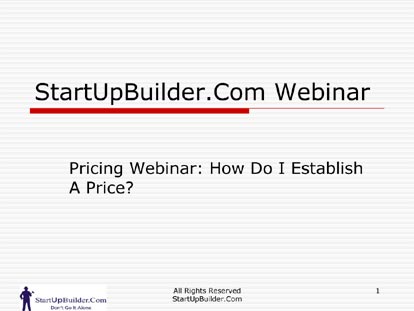 |
Welcome to the StartUpBuilder.Com webinar
on pricing. One of the most hotly contested
discussion points for many entrepreneurs is
“how to determine what price to charge”
for products and services.
In
this webinar, we will explore some of the
key issues surrounding pricing and provide
you with insights you can apply to your
own situations.
|
 |

|
As a serial
entrepreneur myself, I am very familiar with
the importance of pricing and have previously
struggled with the best ways to go about establishing
a price point in the market for my products
and services.
In fact,
this topic is so critical to me (and to
most entrepreneurs) that I devote considerable
time and space to it in my two books, “How
To Succeed As An Independent Consultant,
4th Ed. (published by John Wiley & Sons)
and “The Quintessential Guide To Using
Consultants” (published by HRD Press).
Both of these books are available online
at www.amazon.com, www.bn.com, or www.borders.com,
as well as “brick and mortar”
bookselling retailers.
In addition,
I frequently publish articles in publications
as varied as; BusinessWeek Online, Connecticut
Post, Training and Development, Grocery
Headquarters, and many others, as well as
so-called “e-zines.” I am often
called upon to provide context for radio
interviews around small business issues,
of which pricing is a key component. Lastly,
I am a repeat presenter at numerous industry
conferences and corporate events where pricing
is a topic that often gets discussed.
|
 |
|
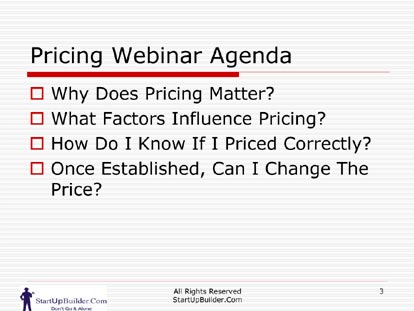 |
Our webinar will cover the following topics:
• Why does pricing matter
• What factors influence pricing and
how to best manage them in your favor
• Determining whether pricing is at the
appropriate or correct level
• Deciding if a price that has been established
in the market can be changed, and how to do
that.
|
 |
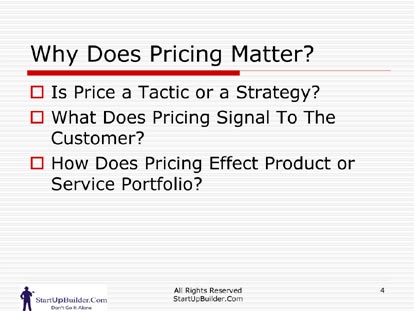 |
Pricing
is both a tactic and has strategic implications.
As a tactic
- it is one of what are commonly referred
to as the “4 P’s”:
Product –
what is the ‘offer’ being provided
or the service being extended to the market?
In short, what it is you are trying to sell?
Placement – where do you attempt to
sell it? Online? In retail stores? Through
Distributors? Etc. How do you wish to be
compared to others in the marketplace? Do
you want to have a “side by side”
comparison with the market leader? Are you
looking to “break new ground”
with your product/service by opening up
new distribution opportunities?
Promotion – how is the product advertised
or marketed? Are you relying on word of
mouth campaigns? Search engine optimization
techniques, or other methods for driving
business to you/your business?
Price – what is the investment or cost
you expect customers to pay in order to
become a part of your clientele? How does
that match or mirror what other competitors
are charging?
As a strategy,
price communicates a certain “quality”
to most people. In the absence of other
information, many customers assume or default
to the belief that a higher priced item
is made of better materials, has more features,
or in some other way is an improvement over
lesser priced goods and services.
Your pricing
will signal what you wish the perception
of your product or service to be in the
minds of customers or clients. Of course,
the other factors that commonly impact perception
need to be aligned with the price to sustain
that image (packaging, advertising or marketing
support, etc.). A plain brown paper bagged
item does not convey the same product image
as if it comes wrapped in a blue box with
a ribbon that clearly is associated with
Tiffany’s jewelry store.
The last
point on this slide is making sure that
your products or services reflect the “graduated
levels” of offering you provide. It
would be confusing for the customer to pay
the same price for your “entry-level”
items as they do for your more enhanced
products and services. There ideally should
be an incremental difference as products
or services become more fully featured or
more comprehensive/complex. Be certain that
your own products/services are reflective
of the value you are intending the customer
interpret in each of them.
|
 |
 |
When
determining the price of items, it is essential
that the following be considered:
What are
your costs to produce or provide the product/service?
Include both the raw goods costs (ingredients,
components, etc.) and the indirect costs
that the business must absorb, but are “spread
out over” all customer orders. While
the computer or the light bill is not going
to change dramatically on a project by project
basis and it may not be easy to apportion
out to each customer’s order the “fair
share” of those costs – they need
to be accounted for in the price or the
business will lose money by only covering
its “direct” costs of raw goods
and not the additional costs required to
run the business (health insurance, vehicles,
owner salary, etc.).
In most cases,
the competition will already have established
a “range” of pricing (unless you
are the first to market or creator of a
new product) and you will be compared against
the “market expectation” for pricing.
While your service or product may exceed
the competition, or you may feel you are
offering only the most essential aspects
of what customers want or need and nothing
more – you will still be based on what
other competitors charge. Are you “worth”
twice what they are? Are you able to gain
market share or customers by charging a
10% less price (or will it take a bigger
discount)?
How much
interest is there in the market for your
product? Obviously, when demand is high,
there is a greater chance to charge more
for it (subject to competitive conditions).
If the market has little use for what you
offer – even if it is the BEST on the
market – it is not going to likely
lead to many sales.
Profit requirements
are also necessary in determining pricing.
Different business models will approach
the “how to” of this uniquely.
Some businesses prefer to sell “mass
appeal” products at a low margin (meaning
less profit per sale), but intend to sell
many of them to reach a profit target. Other
businesses will look at the opportunity
or segment their target market and determine
that they would rather sell fewer items,
but do it at a much larger margin. Regardless
of which approach is used – they both
should be driven by what the eventual profit
target or goal is (and then build pricing
to support that and still be reflective
of the other concerns listed).
|
 |
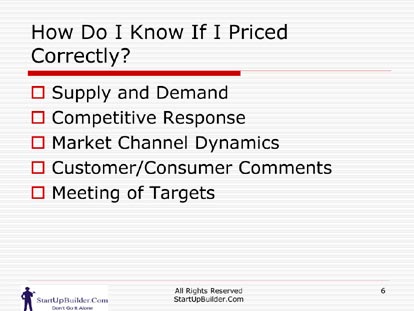 |
The market
will quickly tell you if you are priced correctly.
Do customers
flock to you and purchase large quantities
when you drop the price? Do they prefer
to buy from competition when your prices
are raised? Finding that exact “cost/benefit”
or “value” level can be a matter
of trial and error at times – but it
can be done by paying attention to the response
received or generated.
Does competition
tend to follow your lead (when you drop
price, they drop price? If you raise price,
they remain where they are, etc.)?
How the product
is sold, or the “go to market”
approach can influence pricing – customers
may be willing to pay more for items that
are conveniently delivered to their doors
versus those that they have to seek out
in a store to purchase. Internet purchased
items are often priced differently than
those available elsewhere for this reason.
On the other hand, the reverse can also
be true in some instances – because
there is no “cost” associated
with selling the product, customers expect
in certain instances that the price will
be less online, as the stocking, warehousing,
and labor costs typically absorbed by a
store carrying that item are not absorbed
when sold online. Knowing your customer
and how the product is shopped is essential
to meet pricing criteria.
What comments
or feedback do you receive from customers
when they purchase from you? Are they generally
positive? Do they make mention of what a
bargain or a steal they are getting? Or,
do they constantly refer to how a competitor
is undercutting your prices for essentially
the same offering? (be aware though, they
are buying from you as they say this…so
while they may be complaining, there is
still a reason why they purchase from you
and not your competition).
The last
point is – are you meeting your profit,
volume, customer targets? If not, it may
be pricing related. Examine whether there
are other factors influencing that, or if
it is a price point that can be adjusted
up or down to meet your established targets.
|
 |
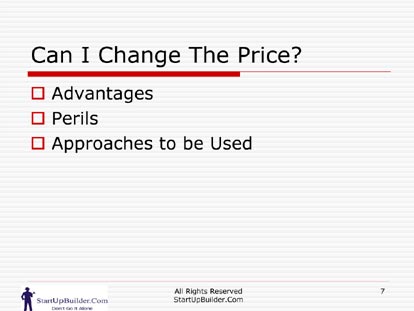 |
When
changing the price – the potential upside
is that you can either:
• Drive more trial or sales to your product
or service by lowering the price and thereby
reducing the “risk” to buy from
you.
• Increase margin per unit sold by increasing
the price paid for the product or service.
Of course,
this assumes that the SAME level of sales
will occur (which rarely happens in real
life…higher prices tend to reduce quantity
of sales and lower prices increase sales
– BUT, is the difference sufficient
enough to make up for what is “lost”
by changing the price?). Will sales gained
more than outweigh the reduced margin on
a per unit basis? Will margin acquired make
up for the lost sales opportunities?
The downside
is that if you change the price, you can
also change the perception of the product
or service in the minds and eyes of customers.
If I paid more for your offering last year,
and now you lower the price…I may feel
betrayed and feel cheated (it was not worth
what I paid for it). If you raise the price
on me, I may feel that you “tricked
me” into trying it and now are looking
to sneak one by me by increasing the price
and hoping I won’t notice.
When choosing
to change price, be aware of how closely
the customer knows the price to begin with.
In a frequently purchased product or service
(buying white bread or automobile fuel,
most of us know the price point last paid
within a couple of pennies). In a less frequently
purchased product or service, the price
may be more variable and subject to changing
without any real noticeable drop off in
volume (automobile tire rotation or buying
house paint for most people is done infrequently
and the price points are less certain in
the minds of most consumers).
If a price
is about to change, give loyal customers
a chance to “stock up” ahead of
a price change (we are going to change our
prices as of June 1st, but if you order
now, we will honor current prices through
the end of the year). If pricing will drop,
allow preferred customers to get a head
start prior to the drop (as of November,
our prices will decrease by 10%, but as
a loyal customer, we will extend that lower
price to you now for all orders over $XX.).
|
 |
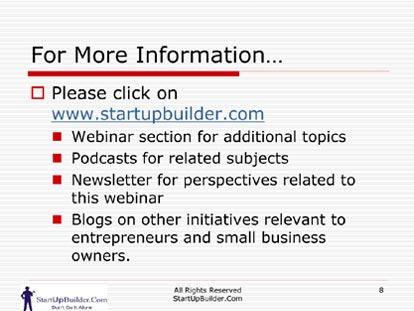 |
We invite
you to participate in all of the interactive
features of StartUpBuilder.Com and welcome
your insights, successes, experiences, and
questions. Be sure to visit us at any of the
other features of the Silver subscription
offerings on the website:
Other webinars
Podcasts
with leading experts and business owners
Our newsletter
And, as always,
our blogs where you get to share your thoughts
and posts with the StartUpBuilder.Com community
– Don’t Go It Alone!
|
| |
| |
|
|
|
| |
|
|
|
|
|
